Implementing Augmented Reality in Education at XYZ University
VerifiedAdded on 2023/04/21
|18
|3886
|416
Report
AI Summary
This report investigates the implementation of augmented reality (AR) technology at XYZ University, focusing on its potential to enhance teaching and learning. The report begins with an executive summary outlining the key areas of investigation, including AR implementation strategies, risk assessment, and the identification of advantages and disadvantages. It then provides an overview of AR, its current applications in various industries, and opportunities for its application within the university, particularly in disciplines such as arts and design, architecture, and production engineering. The report further details the infrastructure requirements for AR integration, analyzes the advantages and disadvantages of the technology, and conducts a risk analysis. Recommendations are provided to guide both technical and non-technical members of the University. The report concludes by emphasizing the potential of AR to improve teaching quality, increase student enrollment, and provide academic value to the students. The report uses peer-reviewed journals and industry reports to support its findings and recommendations.
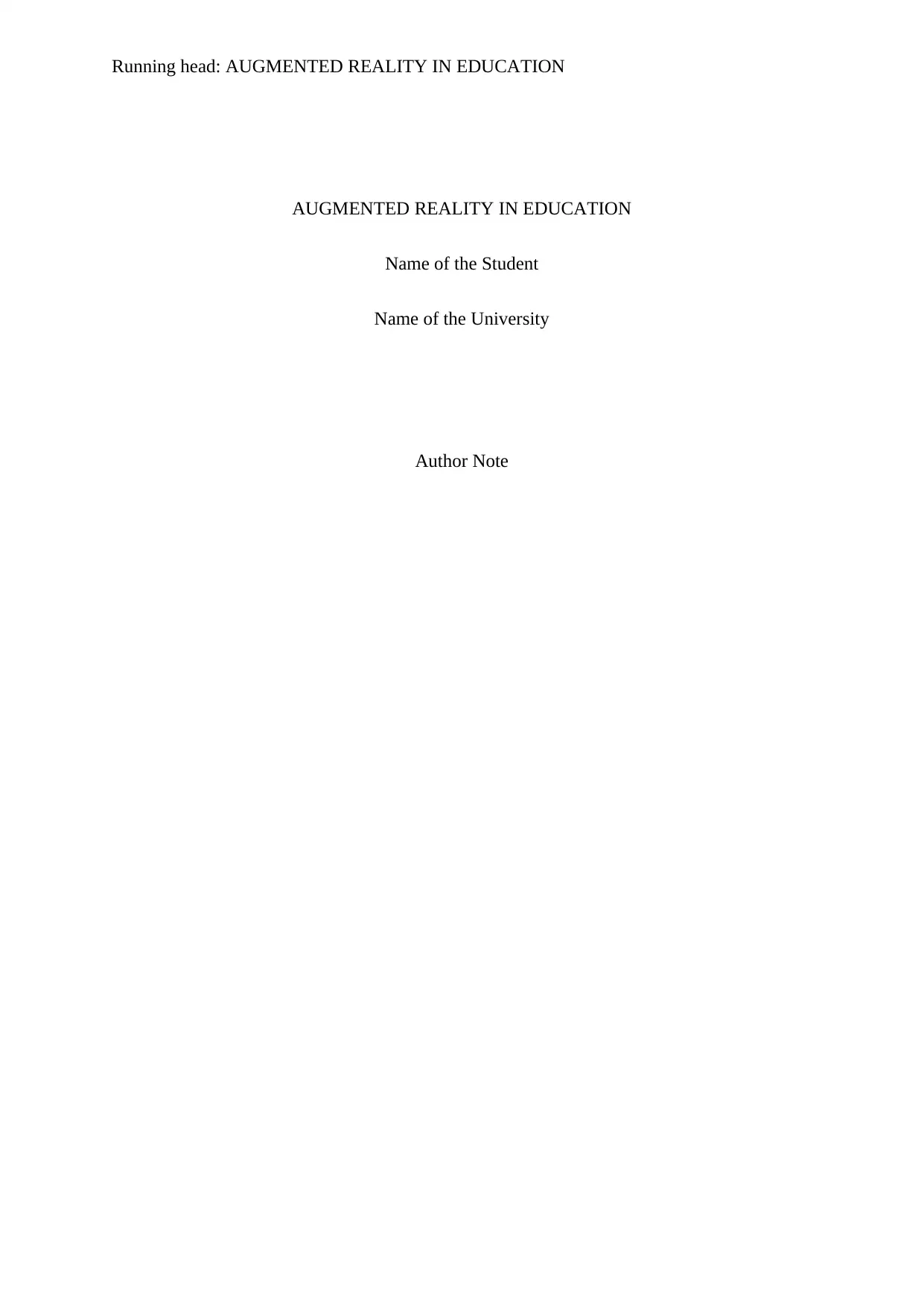
Running head: AUGMENTED REALITY IN EDUCATION
AUGMENTED REALITY IN EDUCATION
Name of the Student
Name of the University
Author Note
AUGMENTED REALITY IN EDUCATION
Name of the Student
Name of the University
Author Note
Paraphrase This Document
Need a fresh take? Get an instant paraphrase of this document with our AI Paraphraser
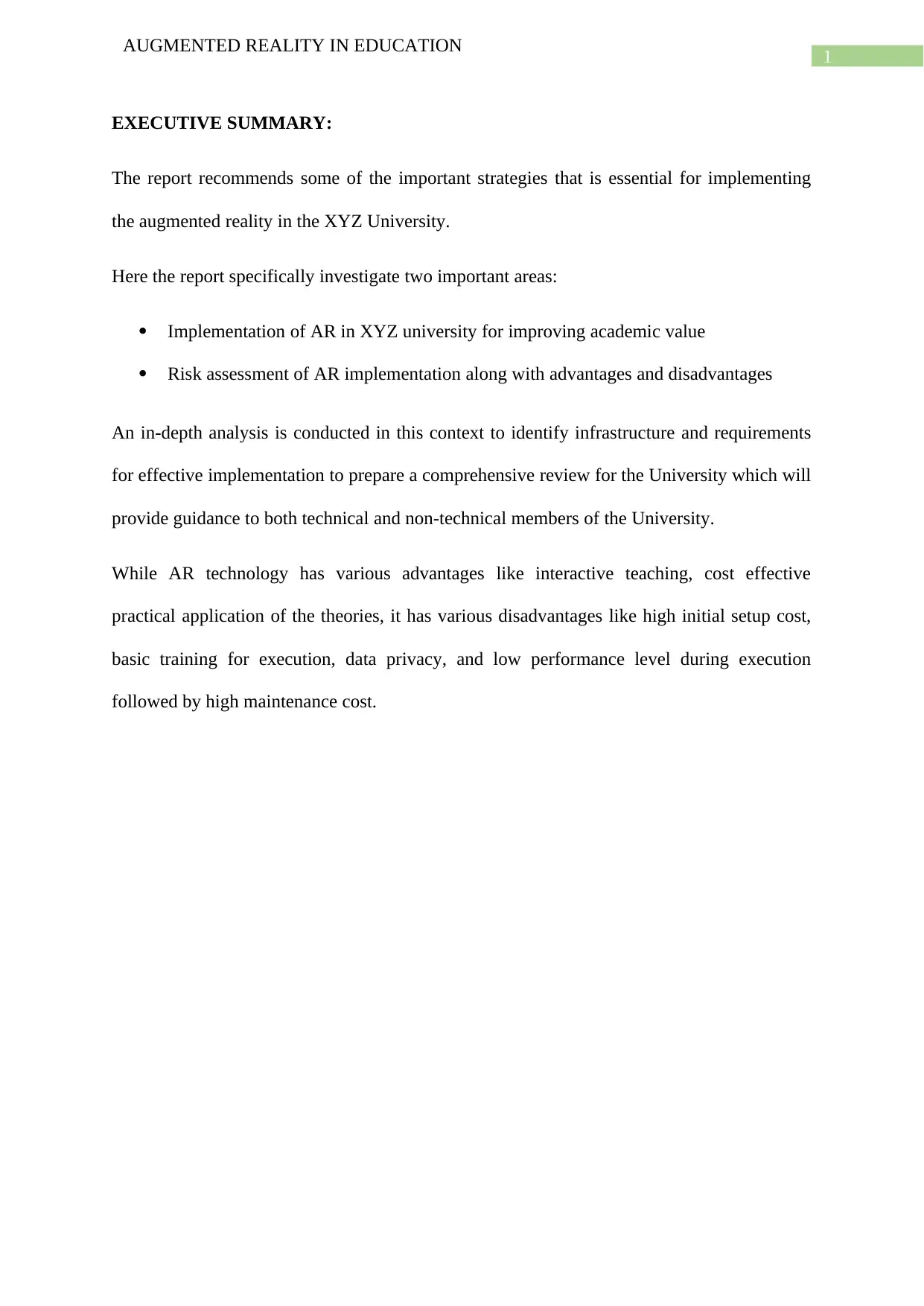
1
AUGMENTED REALITY IN EDUCATION
EXECUTIVE SUMMARY:
The report recommends some of the important strategies that is essential for implementing
the augmented reality in the XYZ University.
Here the report specifically investigate two important areas:
Implementation of AR in XYZ university for improving academic value
Risk assessment of AR implementation along with advantages and disadvantages
An in-depth analysis is conducted in this context to identify infrastructure and requirements
for effective implementation to prepare a comprehensive review for the University which will
provide guidance to both technical and non-technical members of the University.
While AR technology has various advantages like interactive teaching, cost effective
practical application of the theories, it has various disadvantages like high initial setup cost,
basic training for execution, data privacy, and low performance level during execution
followed by high maintenance cost.
AUGMENTED REALITY IN EDUCATION
EXECUTIVE SUMMARY:
The report recommends some of the important strategies that is essential for implementing
the augmented reality in the XYZ University.
Here the report specifically investigate two important areas:
Implementation of AR in XYZ university for improving academic value
Risk assessment of AR implementation along with advantages and disadvantages
An in-depth analysis is conducted in this context to identify infrastructure and requirements
for effective implementation to prepare a comprehensive review for the University which will
provide guidance to both technical and non-technical members of the University.
While AR technology has various advantages like interactive teaching, cost effective
practical application of the theories, it has various disadvantages like high initial setup cost,
basic training for execution, data privacy, and low performance level during execution
followed by high maintenance cost.
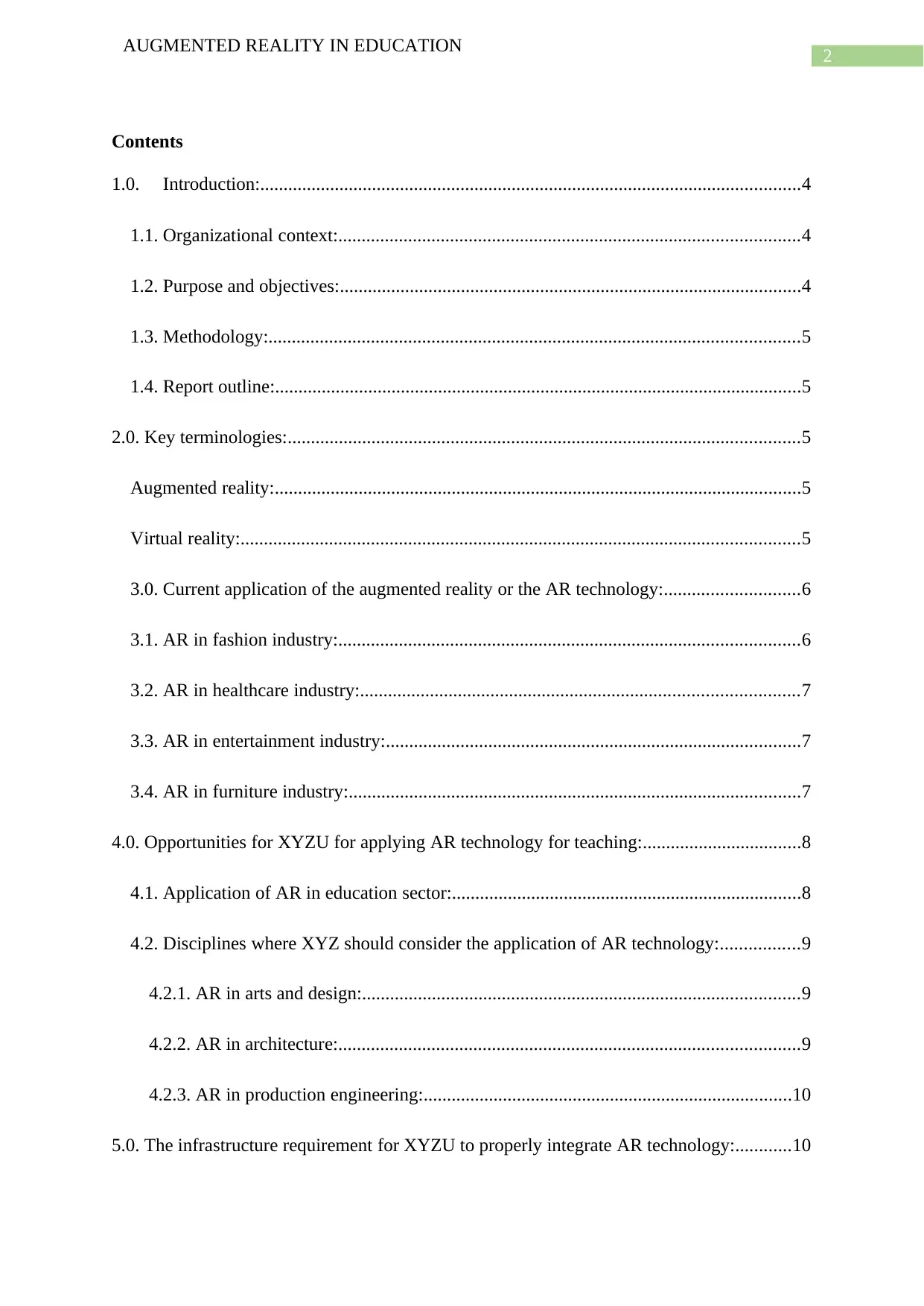
2
AUGMENTED REALITY IN EDUCATION
Contents
1.0. Introduction:....................................................................................................................4
1.1. Organizational context:...................................................................................................4
1.2. Purpose and objectives:...................................................................................................4
1.3. Methodology:..................................................................................................................5
1.4. Report outline:.................................................................................................................5
2.0. Key terminologies:..............................................................................................................5
Augmented reality:.................................................................................................................5
Virtual reality:........................................................................................................................5
3.0. Current application of the augmented reality or the AR technology:.............................6
3.1. AR in fashion industry:...................................................................................................6
3.2. AR in healthcare industry:..............................................................................................7
3.3. AR in entertainment industry:.........................................................................................7
3.4. AR in furniture industry:.................................................................................................7
4.0. Opportunities for XYZU for applying AR technology for teaching:..................................8
4.1. Application of AR in education sector:...........................................................................8
4.2. Disciplines where XYZ should consider the application of AR technology:.................9
4.2.1. AR in arts and design:..............................................................................................9
4.2.2. AR in architecture:...................................................................................................9
4.2.3. AR in production engineering:...............................................................................10
5.0. The infrastructure requirement for XYZU to properly integrate AR technology:............10
AUGMENTED REALITY IN EDUCATION
Contents
1.0. Introduction:....................................................................................................................4
1.1. Organizational context:...................................................................................................4
1.2. Purpose and objectives:...................................................................................................4
1.3. Methodology:..................................................................................................................5
1.4. Report outline:.................................................................................................................5
2.0. Key terminologies:..............................................................................................................5
Augmented reality:.................................................................................................................5
Virtual reality:........................................................................................................................5
3.0. Current application of the augmented reality or the AR technology:.............................6
3.1. AR in fashion industry:...................................................................................................6
3.2. AR in healthcare industry:..............................................................................................7
3.3. AR in entertainment industry:.........................................................................................7
3.4. AR in furniture industry:.................................................................................................7
4.0. Opportunities for XYZU for applying AR technology for teaching:..................................8
4.1. Application of AR in education sector:...........................................................................8
4.2. Disciplines where XYZ should consider the application of AR technology:.................9
4.2.1. AR in arts and design:..............................................................................................9
4.2.2. AR in architecture:...................................................................................................9
4.2.3. AR in production engineering:...............................................................................10
5.0. The infrastructure requirement for XYZU to properly integrate AR technology:............10
⊘ This is a preview!⊘
Do you want full access?
Subscribe today to unlock all pages.

Trusted by 1+ million students worldwide
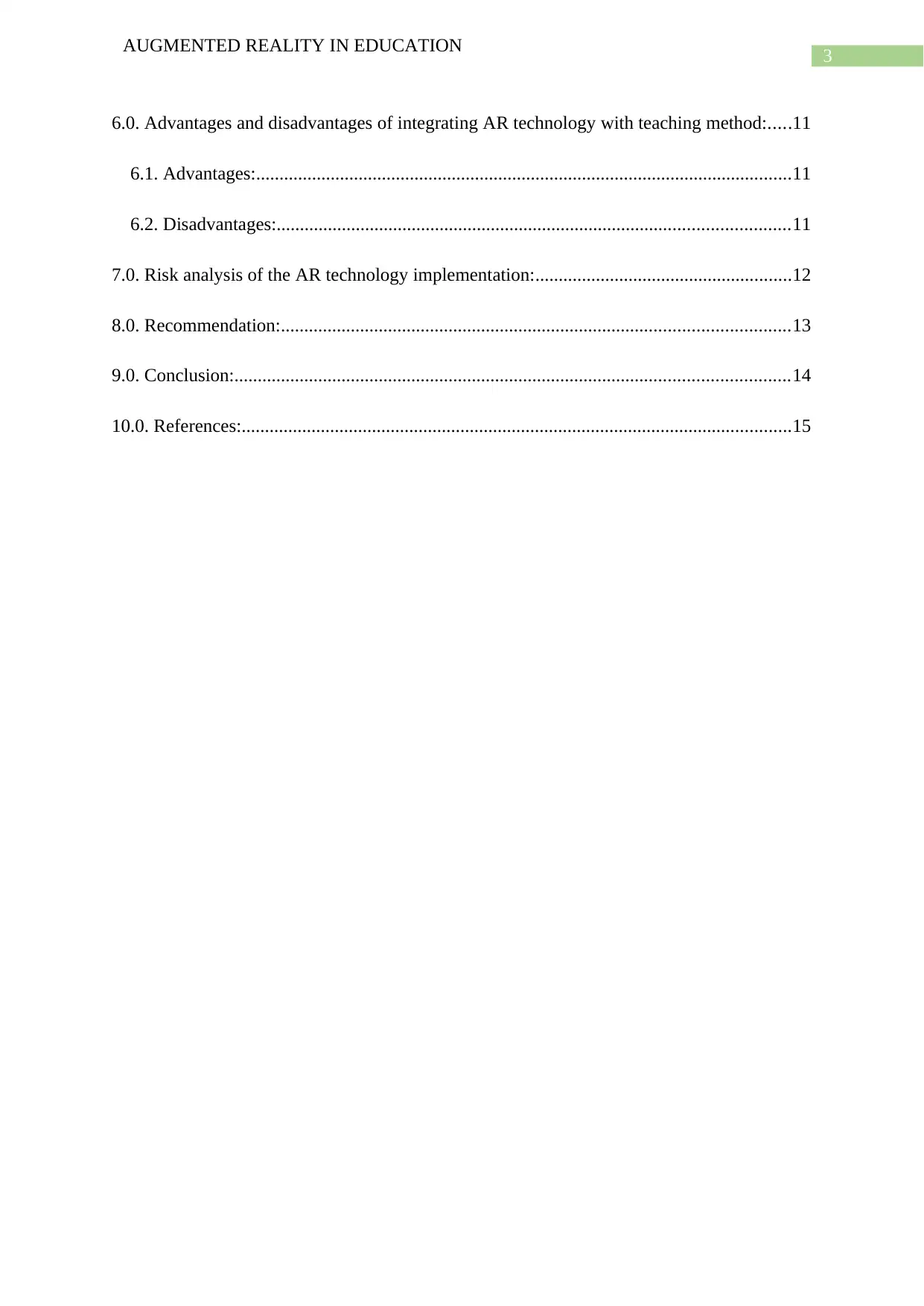
3
AUGMENTED REALITY IN EDUCATION
6.0. Advantages and disadvantages of integrating AR technology with teaching method:.....11
6.1. Advantages:...................................................................................................................11
6.2. Disadvantages:..............................................................................................................11
7.0. Risk analysis of the AR technology implementation:.......................................................12
8.0. Recommendation:.............................................................................................................13
9.0. Conclusion:.......................................................................................................................14
10.0. References:......................................................................................................................15
AUGMENTED REALITY IN EDUCATION
6.0. Advantages and disadvantages of integrating AR technology with teaching method:.....11
6.1. Advantages:...................................................................................................................11
6.2. Disadvantages:..............................................................................................................11
7.0. Risk analysis of the AR technology implementation:.......................................................12
8.0. Recommendation:.............................................................................................................13
9.0. Conclusion:.......................................................................................................................14
10.0. References:......................................................................................................................15
Paraphrase This Document
Need a fresh take? Get an instant paraphrase of this document with our AI Paraphraser
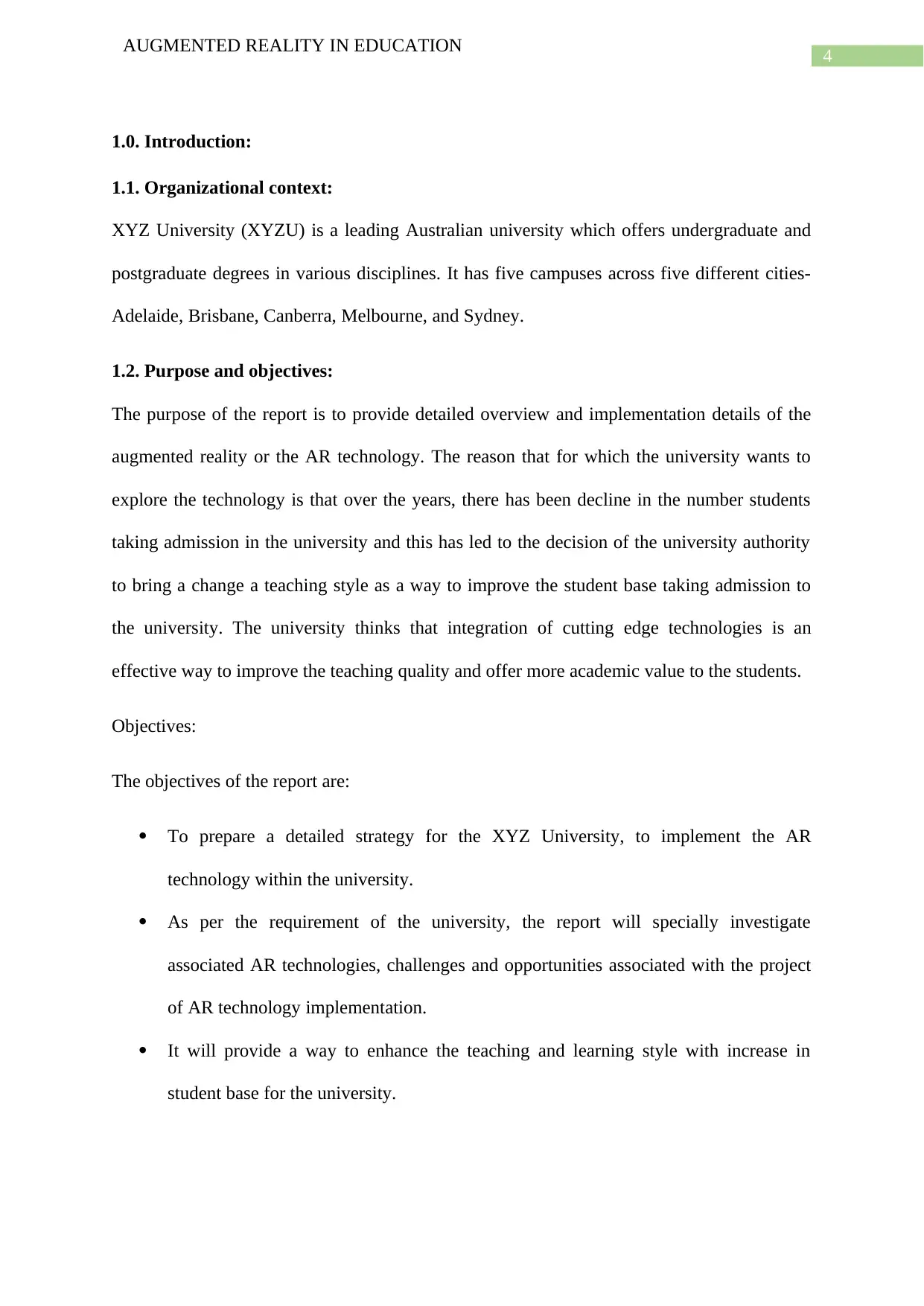
4
AUGMENTED REALITY IN EDUCATION
1.0. Introduction:
1.1. Organizational context:
XYZ University (XYZU) is a leading Australian university which offers undergraduate and
postgraduate degrees in various disciplines. It has five campuses across five different cities-
Adelaide, Brisbane, Canberra, Melbourne, and Sydney.
1.2. Purpose and objectives:
The purpose of the report is to provide detailed overview and implementation details of the
augmented reality or the AR technology. The reason that for which the university wants to
explore the technology is that over the years, there has been decline in the number students
taking admission in the university and this has led to the decision of the university authority
to bring a change a teaching style as a way to improve the student base taking admission to
the university. The university thinks that integration of cutting edge technologies is an
effective way to improve the teaching quality and offer more academic value to the students.
Objectives:
The objectives of the report are:
To prepare a detailed strategy for the XYZ University, to implement the AR
technology within the university.
As per the requirement of the university, the report will specially investigate
associated AR technologies, challenges and opportunities associated with the project
of AR technology implementation.
It will provide a way to enhance the teaching and learning style with increase in
student base for the university.
AUGMENTED REALITY IN EDUCATION
1.0. Introduction:
1.1. Organizational context:
XYZ University (XYZU) is a leading Australian university which offers undergraduate and
postgraduate degrees in various disciplines. It has five campuses across five different cities-
Adelaide, Brisbane, Canberra, Melbourne, and Sydney.
1.2. Purpose and objectives:
The purpose of the report is to provide detailed overview and implementation details of the
augmented reality or the AR technology. The reason that for which the university wants to
explore the technology is that over the years, there has been decline in the number students
taking admission in the university and this has led to the decision of the university authority
to bring a change a teaching style as a way to improve the student base taking admission to
the university. The university thinks that integration of cutting edge technologies is an
effective way to improve the teaching quality and offer more academic value to the students.
Objectives:
The objectives of the report are:
To prepare a detailed strategy for the XYZ University, to implement the AR
technology within the university.
As per the requirement of the university, the report will specially investigate
associated AR technologies, challenges and opportunities associated with the project
of AR technology implementation.
It will provide a way to enhance the teaching and learning style with increase in
student base for the university.
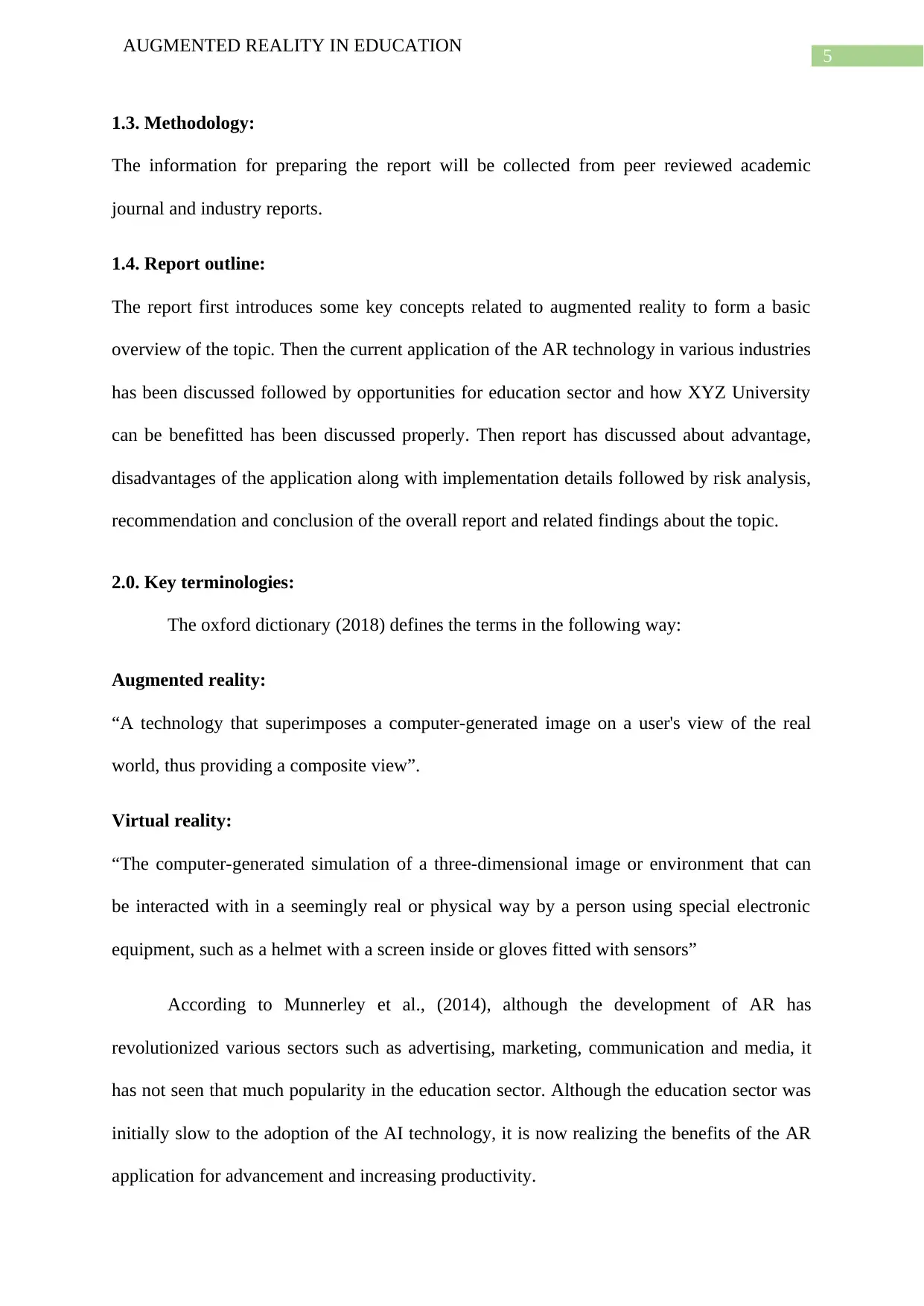
5
AUGMENTED REALITY IN EDUCATION
1.3. Methodology:
The information for preparing the report will be collected from peer reviewed academic
journal and industry reports.
1.4. Report outline:
The report first introduces some key concepts related to augmented reality to form a basic
overview of the topic. Then the current application of the AR technology in various industries
has been discussed followed by opportunities for education sector and how XYZ University
can be benefitted has been discussed properly. Then report has discussed about advantage,
disadvantages of the application along with implementation details followed by risk analysis,
recommendation and conclusion of the overall report and related findings about the topic.
2.0. Key terminologies:
The oxford dictionary (2018) defines the terms in the following way:
Augmented reality:
“A technology that superimposes a computer-generated image on a user's view of the real
world, thus providing a composite view”.
Virtual reality:
“The computer-generated simulation of a three-dimensional image or environment that can
be interacted with in a seemingly real or physical way by a person using special electronic
equipment, such as a helmet with a screen inside or gloves fitted with sensors”
According to Munnerley et al., (2014), although the development of AR has
revolutionized various sectors such as advertising, marketing, communication and media, it
has not seen that much popularity in the education sector. Although the education sector was
initially slow to the adoption of the AI technology, it is now realizing the benefits of the AR
application for advancement and increasing productivity.
AUGMENTED REALITY IN EDUCATION
1.3. Methodology:
The information for preparing the report will be collected from peer reviewed academic
journal and industry reports.
1.4. Report outline:
The report first introduces some key concepts related to augmented reality to form a basic
overview of the topic. Then the current application of the AR technology in various industries
has been discussed followed by opportunities for education sector and how XYZ University
can be benefitted has been discussed properly. Then report has discussed about advantage,
disadvantages of the application along with implementation details followed by risk analysis,
recommendation and conclusion of the overall report and related findings about the topic.
2.0. Key terminologies:
The oxford dictionary (2018) defines the terms in the following way:
Augmented reality:
“A technology that superimposes a computer-generated image on a user's view of the real
world, thus providing a composite view”.
Virtual reality:
“The computer-generated simulation of a three-dimensional image or environment that can
be interacted with in a seemingly real or physical way by a person using special electronic
equipment, such as a helmet with a screen inside or gloves fitted with sensors”
According to Munnerley et al., (2014), although the development of AR has
revolutionized various sectors such as advertising, marketing, communication and media, it
has not seen that much popularity in the education sector. Although the education sector was
initially slow to the adoption of the AI technology, it is now realizing the benefits of the AR
application for advancement and increasing productivity.
⊘ This is a preview!⊘
Do you want full access?
Subscribe today to unlock all pages.

Trusted by 1+ million students worldwide
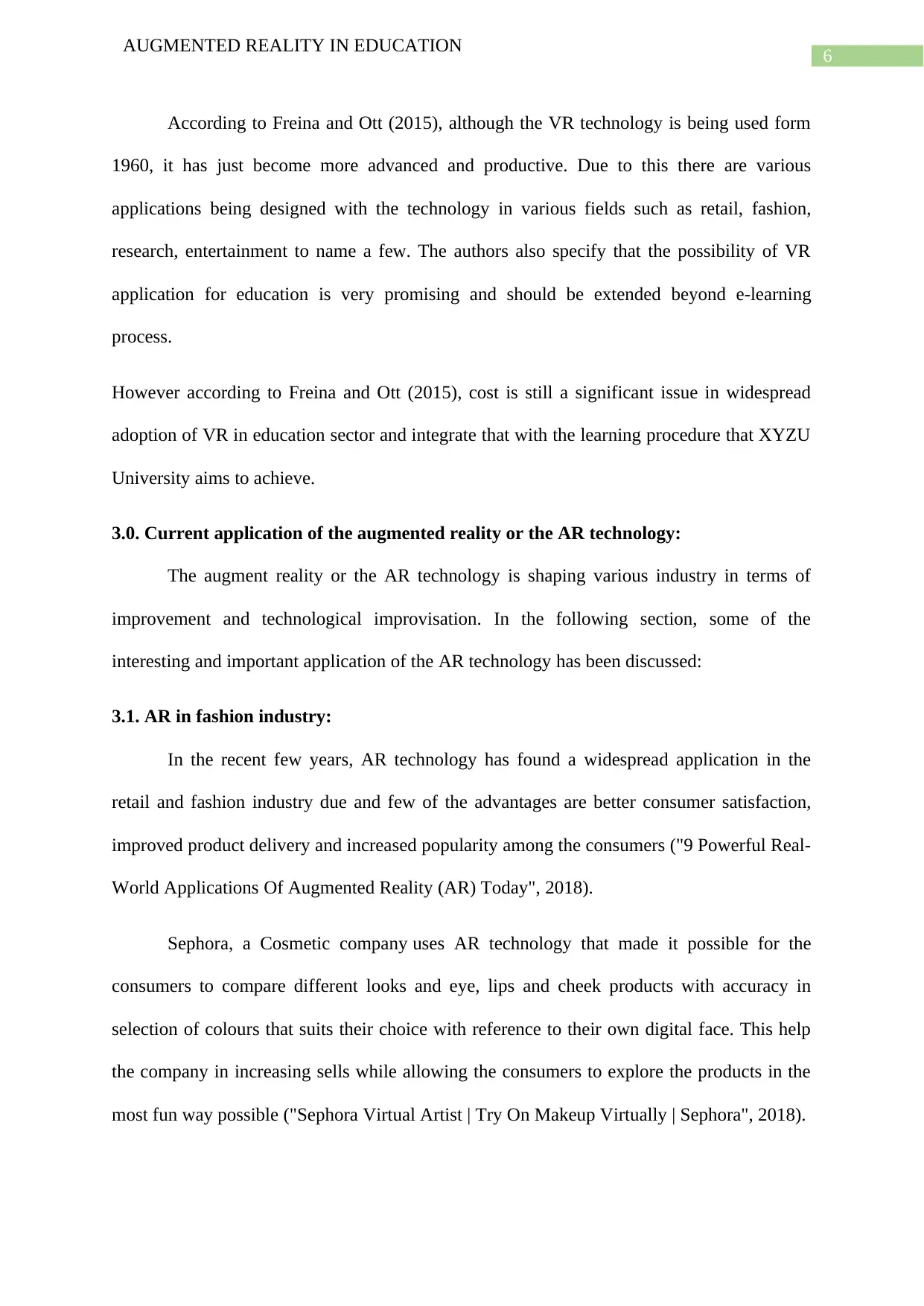
6
AUGMENTED REALITY IN EDUCATION
According to Freina and Ott (2015), although the VR technology is being used form
1960, it has just become more advanced and productive. Due to this there are various
applications being designed with the technology in various fields such as retail, fashion,
research, entertainment to name a few. The authors also specify that the possibility of VR
application for education is very promising and should be extended beyond e-learning
process.
However according to Freina and Ott (2015), cost is still a significant issue in widespread
adoption of VR in education sector and integrate that with the learning procedure that XYZU
University aims to achieve.
3.0. Current application of the augmented reality or the AR technology:
The augment reality or the AR technology is shaping various industry in terms of
improvement and technological improvisation. In the following section, some of the
interesting and important application of the AR technology has been discussed:
3.1. AR in fashion industry:
In the recent few years, AR technology has found a widespread application in the
retail and fashion industry due and few of the advantages are better consumer satisfaction,
improved product delivery and increased popularity among the consumers ("9 Powerful Real-
World Applications Of Augmented Reality (AR) Today", 2018).
Sephora, a Cosmetic company uses AR technology that made it possible for the
consumers to compare different looks and eye, lips and cheek products with accuracy in
selection of colours that suits their choice with reference to their own digital face. This help
the company in increasing sells while allowing the consumers to explore the products in the
most fun way possible ("Sephora Virtual Artist | Try On Makeup Virtually | Sephora", 2018).
AUGMENTED REALITY IN EDUCATION
According to Freina and Ott (2015), although the VR technology is being used form
1960, it has just become more advanced and productive. Due to this there are various
applications being designed with the technology in various fields such as retail, fashion,
research, entertainment to name a few. The authors also specify that the possibility of VR
application for education is very promising and should be extended beyond e-learning
process.
However according to Freina and Ott (2015), cost is still a significant issue in widespread
adoption of VR in education sector and integrate that with the learning procedure that XYZU
University aims to achieve.
3.0. Current application of the augmented reality or the AR technology:
The augment reality or the AR technology is shaping various industry in terms of
improvement and technological improvisation. In the following section, some of the
interesting and important application of the AR technology has been discussed:
3.1. AR in fashion industry:
In the recent few years, AR technology has found a widespread application in the
retail and fashion industry due and few of the advantages are better consumer satisfaction,
improved product delivery and increased popularity among the consumers ("9 Powerful Real-
World Applications Of Augmented Reality (AR) Today", 2018).
Sephora, a Cosmetic company uses AR technology that made it possible for the
consumers to compare different looks and eye, lips and cheek products with accuracy in
selection of colours that suits their choice with reference to their own digital face. This help
the company in increasing sells while allowing the consumers to explore the products in the
most fun way possible ("Sephora Virtual Artist | Try On Makeup Virtually | Sephora", 2018).
Paraphrase This Document
Need a fresh take? Get an instant paraphrase of this document with our AI Paraphraser
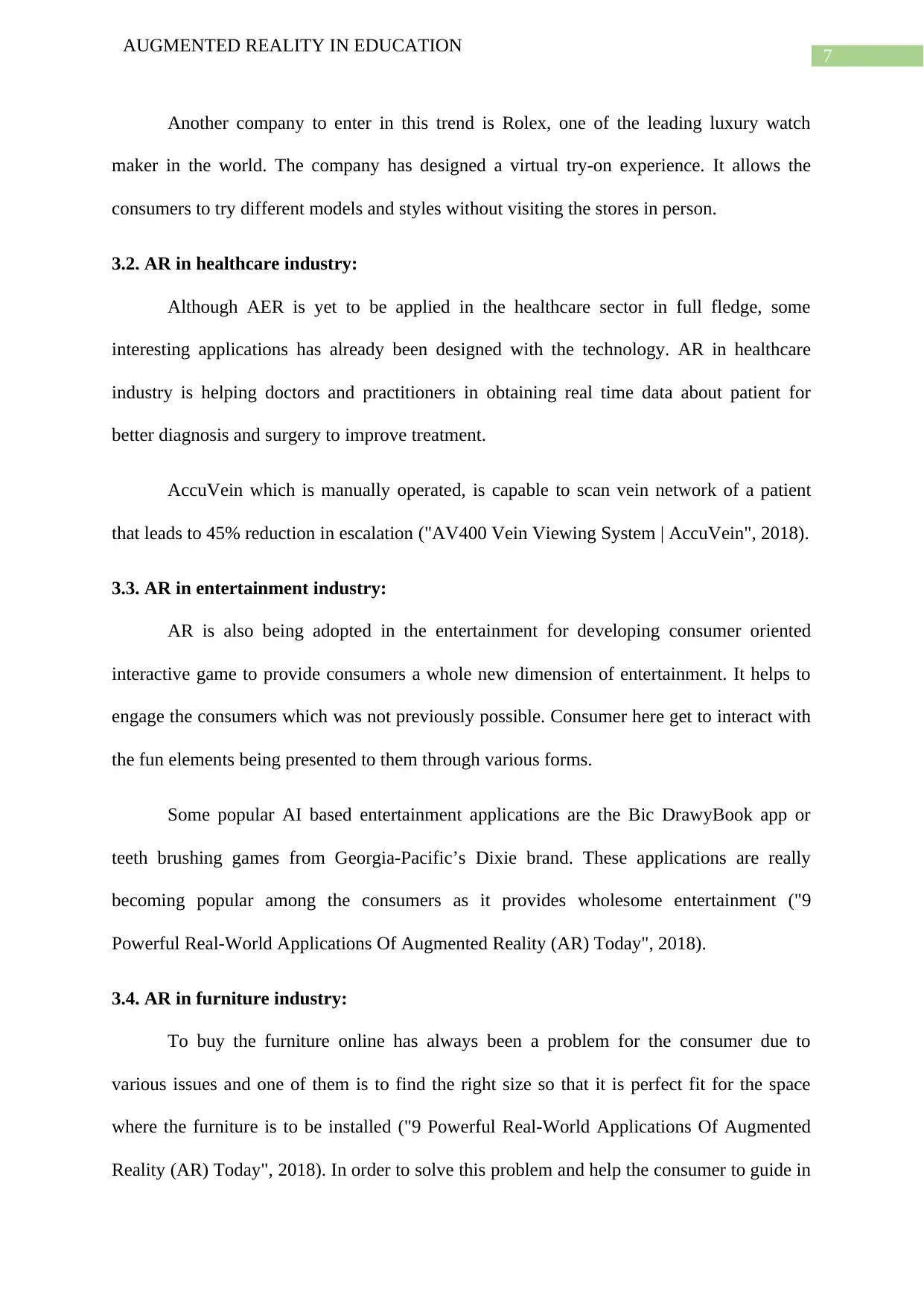
7
AUGMENTED REALITY IN EDUCATION
Another company to enter in this trend is Rolex, one of the leading luxury watch
maker in the world. The company has designed a virtual try-on experience. It allows the
consumers to try different models and styles without visiting the stores in person.
3.2. AR in healthcare industry:
Although AER is yet to be applied in the healthcare sector in full fledge, some
interesting applications has already been designed with the technology. AR in healthcare
industry is helping doctors and practitioners in obtaining real time data about patient for
better diagnosis and surgery to improve treatment.
AccuVein which is manually operated, is capable to scan vein network of a patient
that leads to 45% reduction in escalation ("AV400 Vein Viewing System | AccuVein", 2018).
3.3. AR in entertainment industry:
AR is also being adopted in the entertainment for developing consumer oriented
interactive game to provide consumers a whole new dimension of entertainment. It helps to
engage the consumers which was not previously possible. Consumer here get to interact with
the fun elements being presented to them through various forms.
Some popular AI based entertainment applications are the Bic DrawyBook app or
teeth brushing games from Georgia-Pacific’s Dixie brand. These applications are really
becoming popular among the consumers as it provides wholesome entertainment ("9
Powerful Real-World Applications Of Augmented Reality (AR) Today", 2018).
3.4. AR in furniture industry:
To buy the furniture online has always been a problem for the consumer due to
various issues and one of them is to find the right size so that it is perfect fit for the space
where the furniture is to be installed ("9 Powerful Real-World Applications Of Augmented
Reality (AR) Today", 2018). In order to solve this problem and help the consumer to guide in
AUGMENTED REALITY IN EDUCATION
Another company to enter in this trend is Rolex, one of the leading luxury watch
maker in the world. The company has designed a virtual try-on experience. It allows the
consumers to try different models and styles without visiting the stores in person.
3.2. AR in healthcare industry:
Although AER is yet to be applied in the healthcare sector in full fledge, some
interesting applications has already been designed with the technology. AR in healthcare
industry is helping doctors and practitioners in obtaining real time data about patient for
better diagnosis and surgery to improve treatment.
AccuVein which is manually operated, is capable to scan vein network of a patient
that leads to 45% reduction in escalation ("AV400 Vein Viewing System | AccuVein", 2018).
3.3. AR in entertainment industry:
AR is also being adopted in the entertainment for developing consumer oriented
interactive game to provide consumers a whole new dimension of entertainment. It helps to
engage the consumers which was not previously possible. Consumer here get to interact with
the fun elements being presented to them through various forms.
Some popular AI based entertainment applications are the Bic DrawyBook app or
teeth brushing games from Georgia-Pacific’s Dixie brand. These applications are really
becoming popular among the consumers as it provides wholesome entertainment ("9
Powerful Real-World Applications Of Augmented Reality (AR) Today", 2018).
3.4. AR in furniture industry:
To buy the furniture online has always been a problem for the consumer due to
various issues and one of them is to find the right size so that it is perfect fit for the space
where the furniture is to be installed ("9 Powerful Real-World Applications Of Augmented
Reality (AR) Today", 2018). In order to solve this problem and help the consumer to guide in
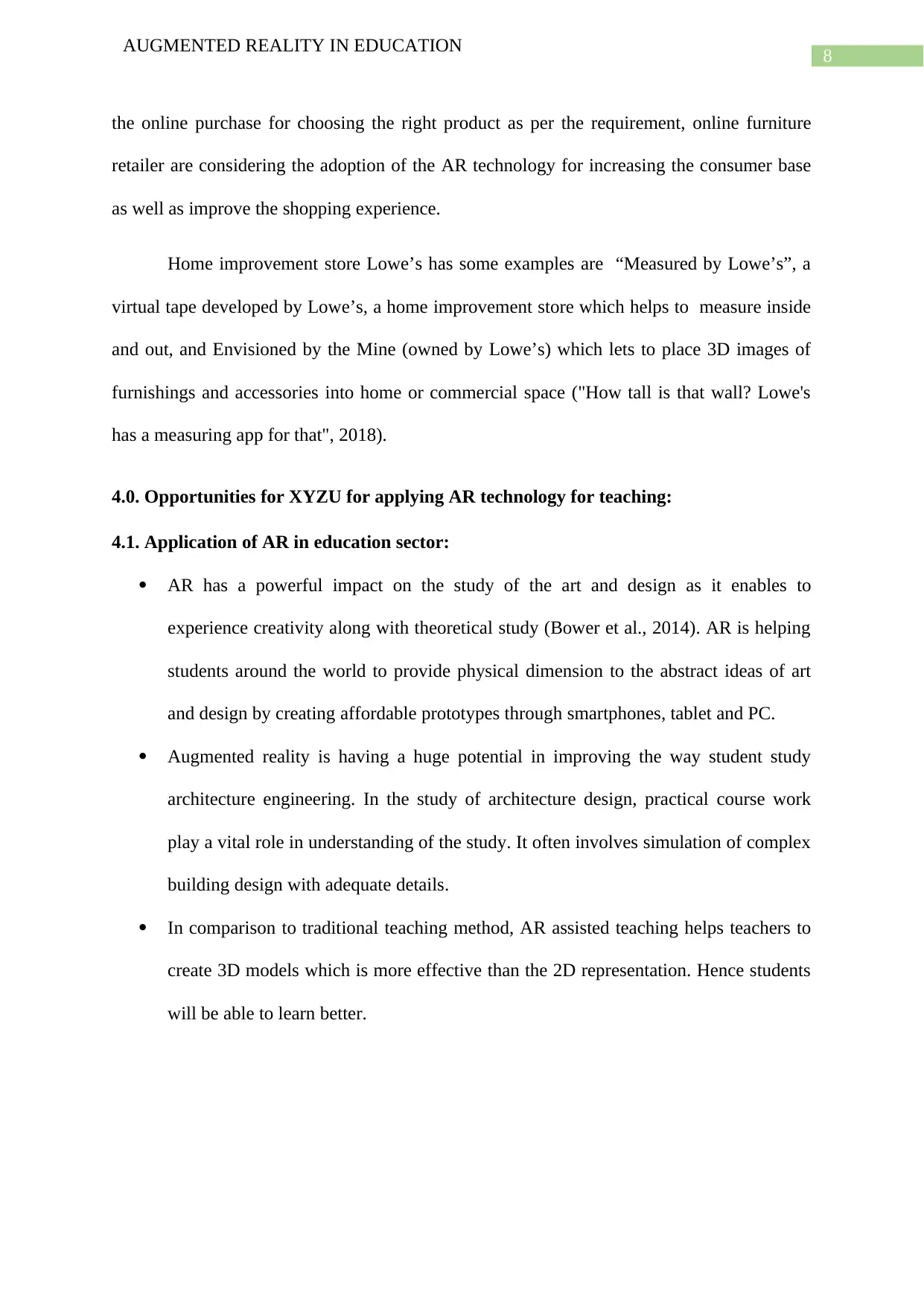
8
AUGMENTED REALITY IN EDUCATION
the online purchase for choosing the right product as per the requirement, online furniture
retailer are considering the adoption of the AR technology for increasing the consumer base
as well as improve the shopping experience.
Home improvement store Lowe’s has some examples are “Measured by Lowe’s”, a
virtual tape developed by Lowe’s, a home improvement store which helps to measure inside
and out, and Envisioned by the Mine (owned by Lowe’s) which lets to place 3D images of
furnishings and accessories into home or commercial space ("How tall is that wall? Lowe's
has a measuring app for that", 2018).
4.0. Opportunities for XYZU for applying AR technology for teaching:
4.1. Application of AR in education sector:
AR has a powerful impact on the study of the art and design as it enables to
experience creativity along with theoretical study (Bower et al., 2014). AR is helping
students around the world to provide physical dimension to the abstract ideas of art
and design by creating affordable prototypes through smartphones, tablet and PC.
Augmented reality is having a huge potential in improving the way student study
architecture engineering. In the study of architecture design, practical course work
play a vital role in understanding of the study. It often involves simulation of complex
building design with adequate details.
In comparison to traditional teaching method, AR assisted teaching helps teachers to
create 3D models which is more effective than the 2D representation. Hence students
will be able to learn better.
AUGMENTED REALITY IN EDUCATION
the online purchase for choosing the right product as per the requirement, online furniture
retailer are considering the adoption of the AR technology for increasing the consumer base
as well as improve the shopping experience.
Home improvement store Lowe’s has some examples are “Measured by Lowe’s”, a
virtual tape developed by Lowe’s, a home improvement store which helps to measure inside
and out, and Envisioned by the Mine (owned by Lowe’s) which lets to place 3D images of
furnishings and accessories into home or commercial space ("How tall is that wall? Lowe's
has a measuring app for that", 2018).
4.0. Opportunities for XYZU for applying AR technology for teaching:
4.1. Application of AR in education sector:
AR has a powerful impact on the study of the art and design as it enables to
experience creativity along with theoretical study (Bower et al., 2014). AR is helping
students around the world to provide physical dimension to the abstract ideas of art
and design by creating affordable prototypes through smartphones, tablet and PC.
Augmented reality is having a huge potential in improving the way student study
architecture engineering. In the study of architecture design, practical course work
play a vital role in understanding of the study. It often involves simulation of complex
building design with adequate details.
In comparison to traditional teaching method, AR assisted teaching helps teachers to
create 3D models which is more effective than the 2D representation. Hence students
will be able to learn better.
⊘ This is a preview!⊘
Do you want full access?
Subscribe today to unlock all pages.

Trusted by 1+ million students worldwide
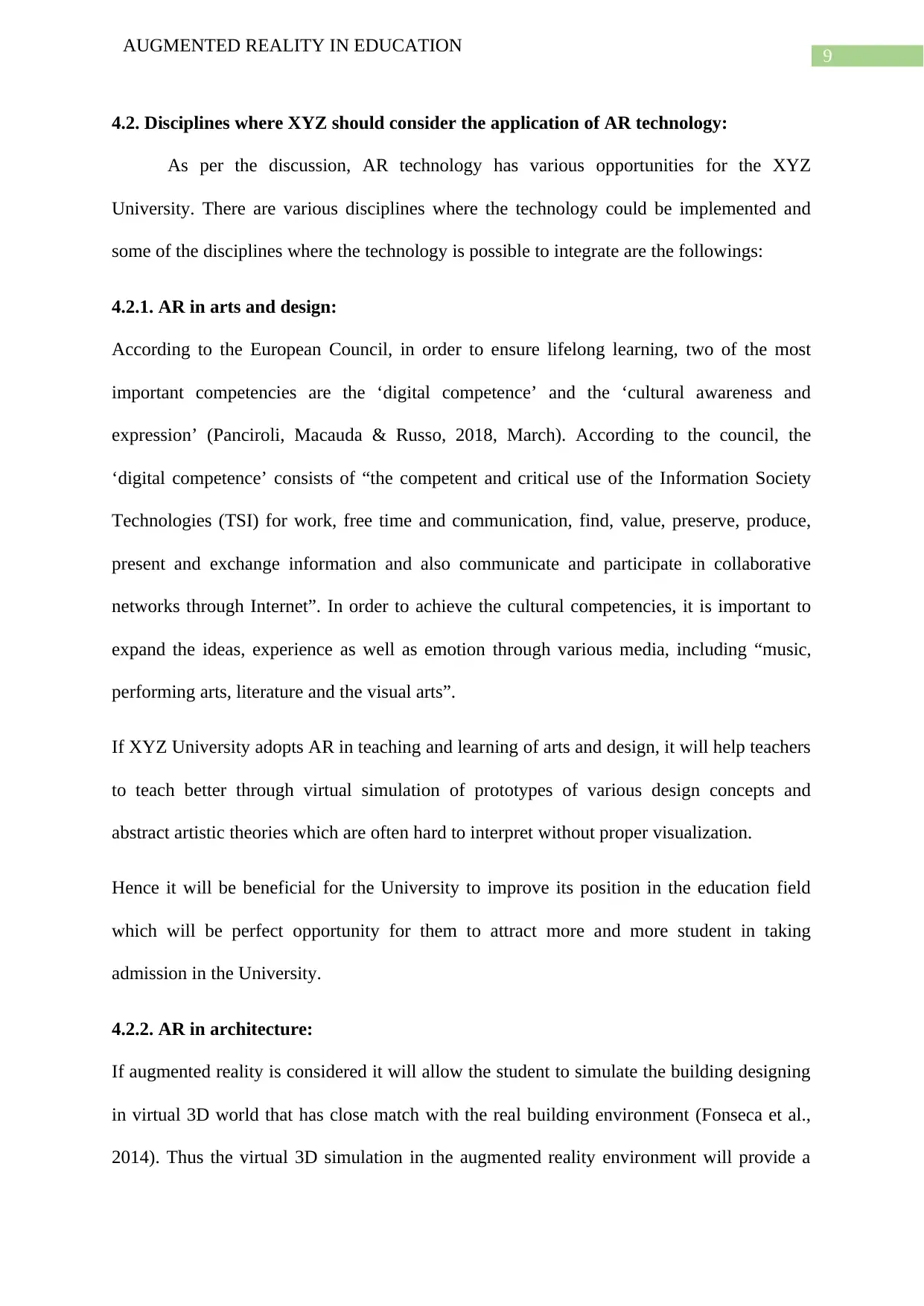
9
AUGMENTED REALITY IN EDUCATION
4.2. Disciplines where XYZ should consider the application of AR technology:
As per the discussion, AR technology has various opportunities for the XYZ
University. There are various disciplines where the technology could be implemented and
some of the disciplines where the technology is possible to integrate are the followings:
4.2.1. AR in arts and design:
According to the European Council, in order to ensure lifelong learning, two of the most
important competencies are the ‘digital competence’ and the ‘cultural awareness and
expression’ (Panciroli, Macauda & Russo, 2018, March). According to the council, the
‘digital competence’ consists of “the competent and critical use of the Information Society
Technologies (TSI) for work, free time and communication, find, value, preserve, produce,
present and exchange information and also communicate and participate in collaborative
networks through Internet”. In order to achieve the cultural competencies, it is important to
expand the ideas, experience as well as emotion through various media, including “music,
performing arts, literature and the visual arts”.
If XYZ University adopts AR in teaching and learning of arts and design, it will help teachers
to teach better through virtual simulation of prototypes of various design concepts and
abstract artistic theories which are often hard to interpret without proper visualization.
Hence it will be beneficial for the University to improve its position in the education field
which will be perfect opportunity for them to attract more and more student in taking
admission in the University.
4.2.2. AR in architecture:
If augmented reality is considered it will allow the student to simulate the building designing
in virtual 3D world that has close match with the real building environment (Fonseca et al.,
2014). Thus the virtual 3D simulation in the augmented reality environment will provide a
AUGMENTED REALITY IN EDUCATION
4.2. Disciplines where XYZ should consider the application of AR technology:
As per the discussion, AR technology has various opportunities for the XYZ
University. There are various disciplines where the technology could be implemented and
some of the disciplines where the technology is possible to integrate are the followings:
4.2.1. AR in arts and design:
According to the European Council, in order to ensure lifelong learning, two of the most
important competencies are the ‘digital competence’ and the ‘cultural awareness and
expression’ (Panciroli, Macauda & Russo, 2018, March). According to the council, the
‘digital competence’ consists of “the competent and critical use of the Information Society
Technologies (TSI) for work, free time and communication, find, value, preserve, produce,
present and exchange information and also communicate and participate in collaborative
networks through Internet”. In order to achieve the cultural competencies, it is important to
expand the ideas, experience as well as emotion through various media, including “music,
performing arts, literature and the visual arts”.
If XYZ University adopts AR in teaching and learning of arts and design, it will help teachers
to teach better through virtual simulation of prototypes of various design concepts and
abstract artistic theories which are often hard to interpret without proper visualization.
Hence it will be beneficial for the University to improve its position in the education field
which will be perfect opportunity for them to attract more and more student in taking
admission in the University.
4.2.2. AR in architecture:
If augmented reality is considered it will allow the student to simulate the building designing
in virtual 3D world that has close match with the real building environment (Fonseca et al.,
2014). Thus the virtual 3D simulation in the augmented reality environment will provide a
Paraphrase This Document
Need a fresh take? Get an instant paraphrase of this document with our AI Paraphraser
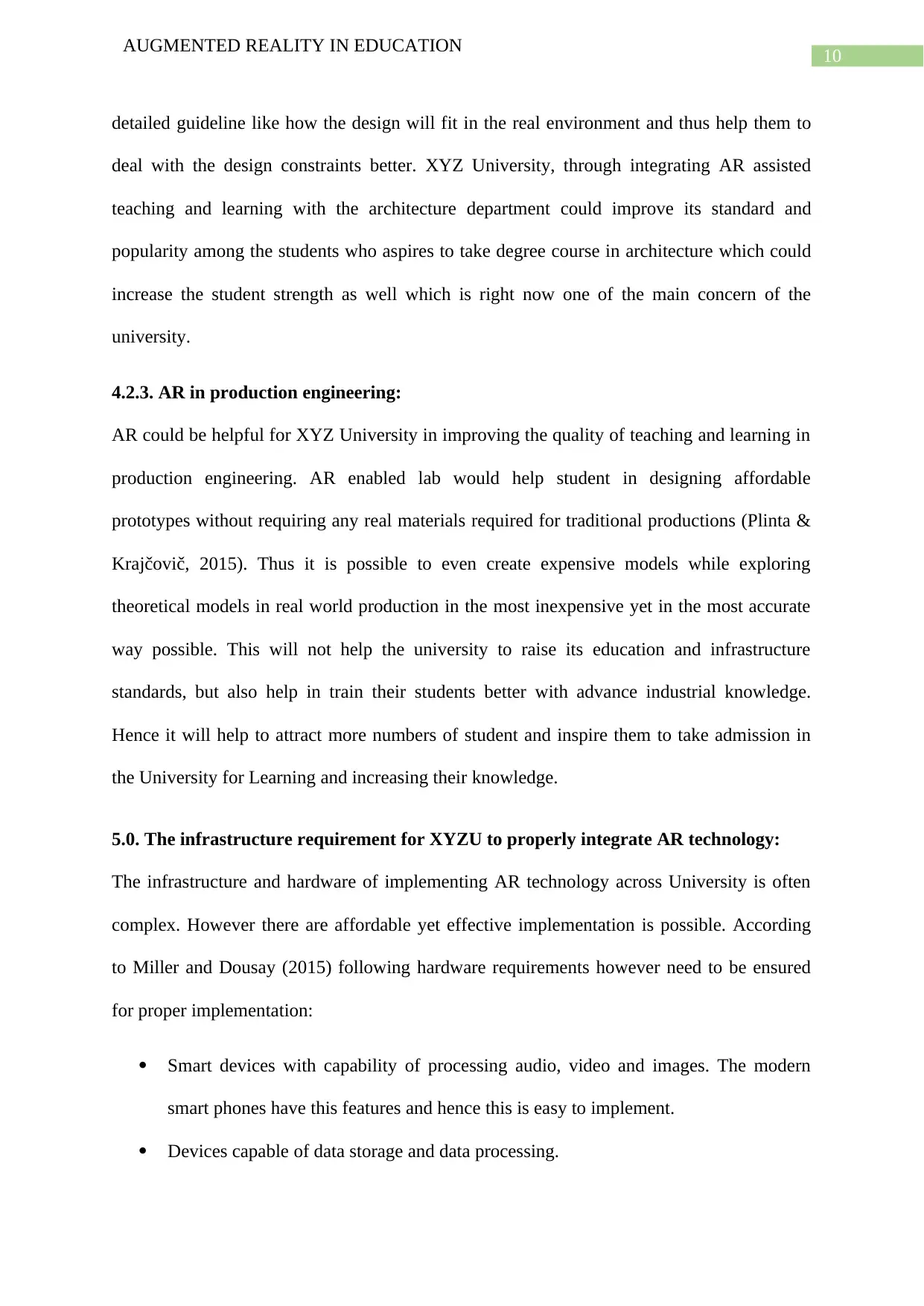
10
AUGMENTED REALITY IN EDUCATION
detailed guideline like how the design will fit in the real environment and thus help them to
deal with the design constraints better. XYZ University, through integrating AR assisted
teaching and learning with the architecture department could improve its standard and
popularity among the students who aspires to take degree course in architecture which could
increase the student strength as well which is right now one of the main concern of the
university.
4.2.3. AR in production engineering:
AR could be helpful for XYZ University in improving the quality of teaching and learning in
production engineering. AR enabled lab would help student in designing affordable
prototypes without requiring any real materials required for traditional productions (Plinta &
Krajčovič, 2015). Thus it is possible to even create expensive models while exploring
theoretical models in real world production in the most inexpensive yet in the most accurate
way possible. This will not help the university to raise its education and infrastructure
standards, but also help in train their students better with advance industrial knowledge.
Hence it will help to attract more numbers of student and inspire them to take admission in
the University for Learning and increasing their knowledge.
5.0. The infrastructure requirement for XYZU to properly integrate AR technology:
The infrastructure and hardware of implementing AR technology across University is often
complex. However there are affordable yet effective implementation is possible. According
to Miller and Dousay (2015) following hardware requirements however need to be ensured
for proper implementation:
Smart devices with capability of processing audio, video and images. The modern
smart phones have this features and hence this is easy to implement.
Devices capable of data storage and data processing.
AUGMENTED REALITY IN EDUCATION
detailed guideline like how the design will fit in the real environment and thus help them to
deal with the design constraints better. XYZ University, through integrating AR assisted
teaching and learning with the architecture department could improve its standard and
popularity among the students who aspires to take degree course in architecture which could
increase the student strength as well which is right now one of the main concern of the
university.
4.2.3. AR in production engineering:
AR could be helpful for XYZ University in improving the quality of teaching and learning in
production engineering. AR enabled lab would help student in designing affordable
prototypes without requiring any real materials required for traditional productions (Plinta &
Krajčovič, 2015). Thus it is possible to even create expensive models while exploring
theoretical models in real world production in the most inexpensive yet in the most accurate
way possible. This will not help the university to raise its education and infrastructure
standards, but also help in train their students better with advance industrial knowledge.
Hence it will help to attract more numbers of student and inspire them to take admission in
the University for Learning and increasing their knowledge.
5.0. The infrastructure requirement for XYZU to properly integrate AR technology:
The infrastructure and hardware of implementing AR technology across University is often
complex. However there are affordable yet effective implementation is possible. According
to Miller and Dousay (2015) following hardware requirements however need to be ensured
for proper implementation:
Smart devices with capability of processing audio, video and images. The modern
smart phones have this features and hence this is easy to implement.
Devices capable of data storage and data processing.
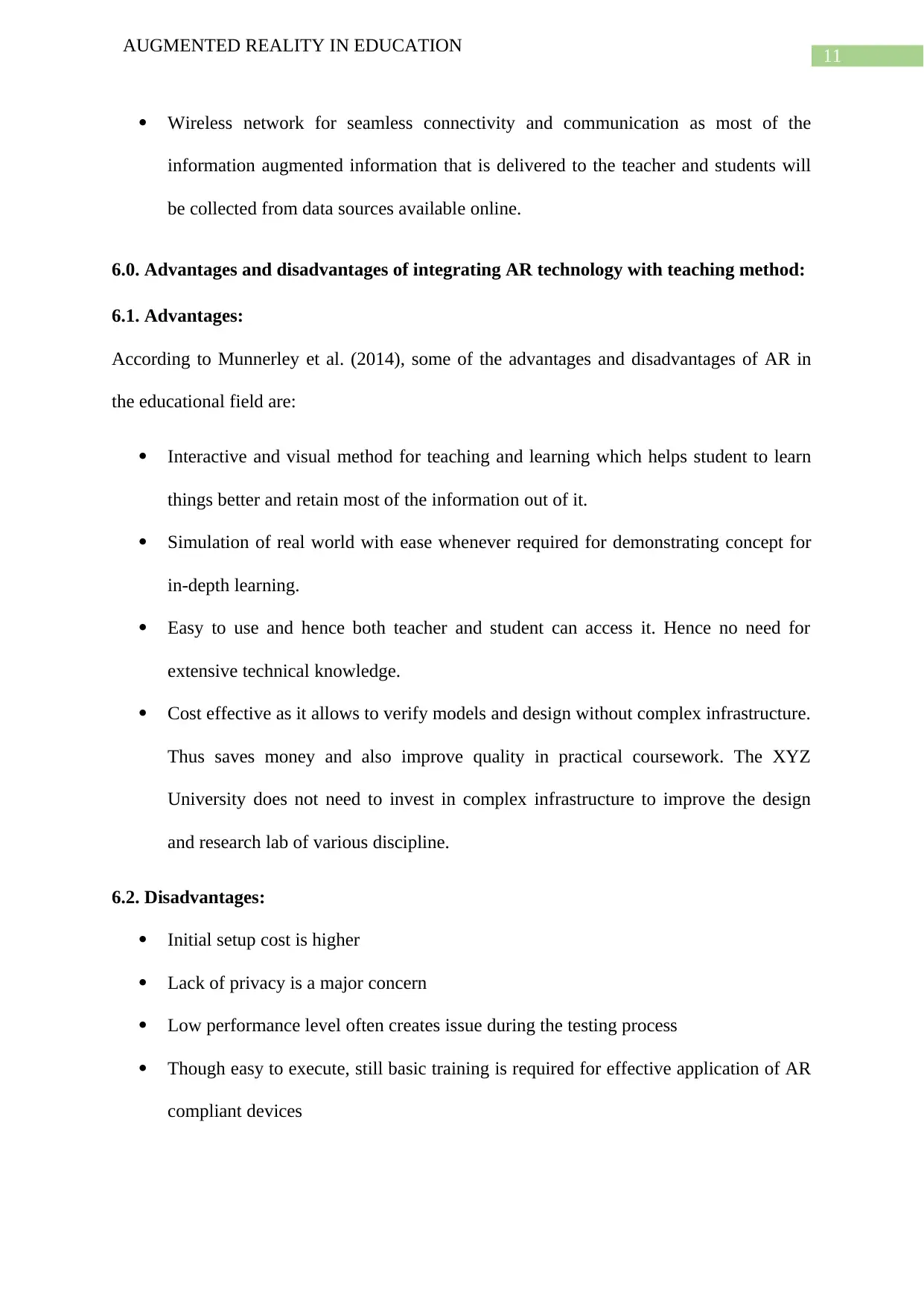
11
AUGMENTED REALITY IN EDUCATION
Wireless network for seamless connectivity and communication as most of the
information augmented information that is delivered to the teacher and students will
be collected from data sources available online.
6.0. Advantages and disadvantages of integrating AR technology with teaching method:
6.1. Advantages:
According to Munnerley et al. (2014), some of the advantages and disadvantages of AR in
the educational field are:
Interactive and visual method for teaching and learning which helps student to learn
things better and retain most of the information out of it.
Simulation of real world with ease whenever required for demonstrating concept for
in-depth learning.
Easy to use and hence both teacher and student can access it. Hence no need for
extensive technical knowledge.
Cost effective as it allows to verify models and design without complex infrastructure.
Thus saves money and also improve quality in practical coursework. The XYZ
University does not need to invest in complex infrastructure to improve the design
and research lab of various discipline.
6.2. Disadvantages:
Initial setup cost is higher
Lack of privacy is a major concern
Low performance level often creates issue during the testing process
Though easy to execute, still basic training is required for effective application of AR
compliant devices
AUGMENTED REALITY IN EDUCATION
Wireless network for seamless connectivity and communication as most of the
information augmented information that is delivered to the teacher and students will
be collected from data sources available online.
6.0. Advantages and disadvantages of integrating AR technology with teaching method:
6.1. Advantages:
According to Munnerley et al. (2014), some of the advantages and disadvantages of AR in
the educational field are:
Interactive and visual method for teaching and learning which helps student to learn
things better and retain most of the information out of it.
Simulation of real world with ease whenever required for demonstrating concept for
in-depth learning.
Easy to use and hence both teacher and student can access it. Hence no need for
extensive technical knowledge.
Cost effective as it allows to verify models and design without complex infrastructure.
Thus saves money and also improve quality in practical coursework. The XYZ
University does not need to invest in complex infrastructure to improve the design
and research lab of various discipline.
6.2. Disadvantages:
Initial setup cost is higher
Lack of privacy is a major concern
Low performance level often creates issue during the testing process
Though easy to execute, still basic training is required for effective application of AR
compliant devices
⊘ This is a preview!⊘
Do you want full access?
Subscribe today to unlock all pages.

Trusted by 1+ million students worldwide
1 out of 18
Related Documents
Your All-in-One AI-Powered Toolkit for Academic Success.
+13062052269
info@desklib.com
Available 24*7 on WhatsApp / Email
![[object Object]](/_next/static/media/star-bottom.7253800d.svg)
Unlock your academic potential
Copyright © 2020–2025 A2Z Services. All Rights Reserved. Developed and managed by ZUCOL.





